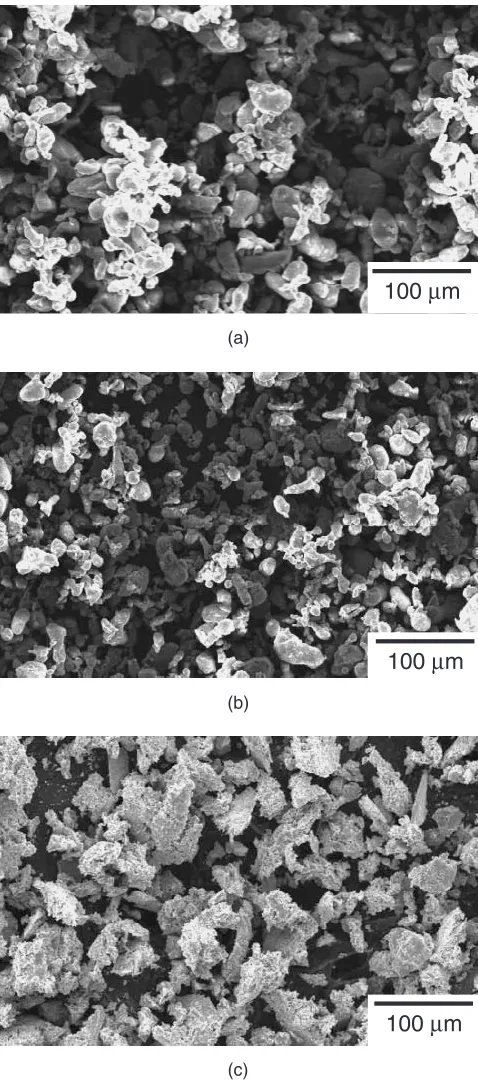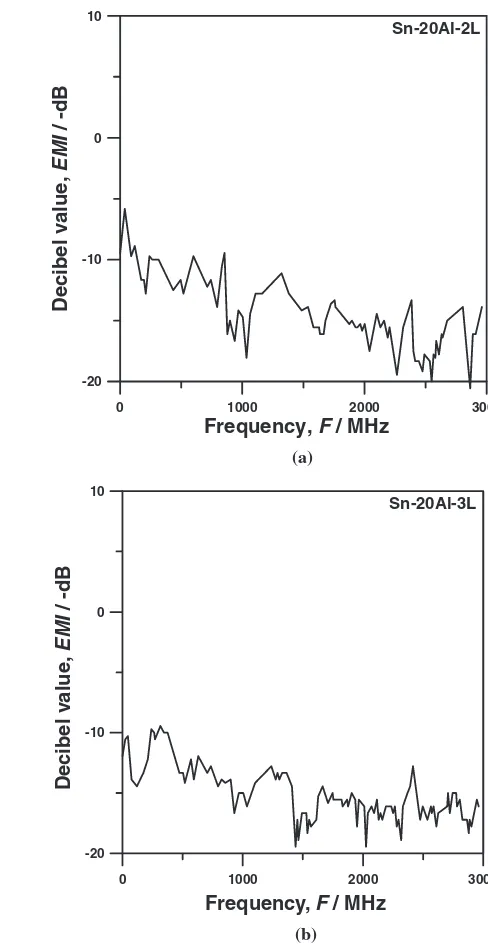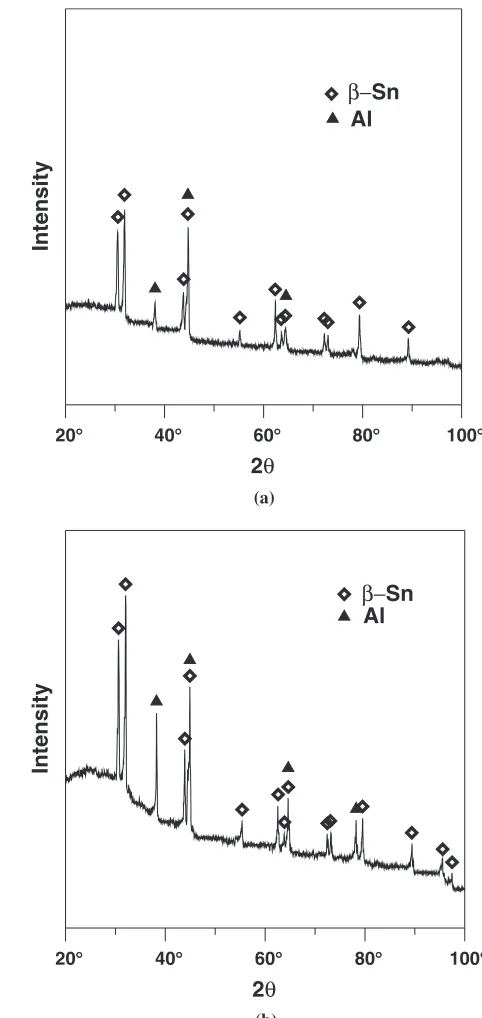National Cheng Kung University, Tainan, Taiwan 701, R. O. China
3Department of Materials Science and Engineering, National Cheng Kung University, Tainan, Taiwan 701, R. O. China
Sn-xAl powder complex materials are used as coating in building materials. This study coats complex colloid mixed with Sn-xAl powders and polyethylene on glass to examine the shield effect on electromagnetic interference (EMI). The results show that adding Al to the Sn-xAl powders can increase the electromagnetic interference (EMI) shield at lower frequencies. Notably, the number of cavities in the coating layer increased with the coating thickness, with the result that the EMI shield could not improve with an increase in the coating thickness at higher frequencies. [doi:10.2320/matertrans.MER2007252]
(Received October 25, 2007; Accepted January 9, 2008; Published February 25, 2008)
Keywords: electromagnetic interference (EMI), Sn-Al, building materials
1. Introduction
In recent years, some research in epidemiology journals has found that people who have been exposed to a high electromagnetic environment for a long duration become more susceptible to leukemia and brain tumors.1,2) In addition, Bioelectrochemistry journal indicated,3)that elec-tromagnetic waves of over 60 Hz will cause damage and variations to the human body’s DNA structure. Relevant literature has shown that people who are exposed to a high electromagnetic environment for a long duration become more susceptible to diseases than normal people.4–6)
There-fore, how to use building materials to improve the electro-magnetic environment is not only a very important issue, but also conforms with the objective of green architecture.7)
Electromagnetic interference (EMI) is a new form of pollution discovered in recent years.8–12) As of now, many
laboratories investigate the technology of electromagnetic interference (EMI) shielding. Some surface technologies possess better EMI shielding, including conductive films13–21)
and mixed conductive powders.22–27)Problems such as wear, peeling, oxidation, hard-working and expensive cost have resulted in the applied capacity of building materials to decrease. However Sn and Al not only possess EMI shield efficiency, but also have acceptable costs28)and can be used to make Sn-xAl powders through a simple process, after which the Sn-xAl powders are mixed with polyethylene to perform the coatings. This study uses Sn-xAl coatings mixed with polyethylene not only to analyze the characteristics of the powders, but also investigate the effects of differing Al content and thicknesses of the EMI shielding so as to further understand the potential for use as a building material.
2. Experimental Method
2.1 Synthetic complex paste
This study selected three kinds of Sn-xAl (x¼20, 30,
40 mass%) powders to perform the EMI shielding experi-ment. The particle size of the irregular Sn-xAl powders was in the range of 10mm–60mm. The polyethylene (x¼20, 25, 30 mass%) was mixed into the Sn-xAl powders to form a complex paste (Sn-xAl and polyethylene). Next, the paste was coated onto a glass plate of dimensions 20cm
15cm2cm. After scraping-form29)and solidification treat-ment at room temperature for 72 hours, a rectangular coating film of 20cm15cm was obtained. After coated, the microstructures of the coatings were determined quantita-tively using a X-ray diffraction (XRD). The Cu-Kstandard (¼1:5403nm) was used and the scanning angle was varied from 20to 100and the scanning velocity was 1min1.
In addition, the number of coating layers was varied from 1-layer, 2-layers and 3-layers (hereafter referred to as x-L). The thickness of each coating layer was in the range of
5010mm. In order to understand the difference in char-acteristics of the powders and the coating layers, the structures of the affected regions were examined using a scanning electron microscope (SEM) to clarify the electro-magnetic shield effect of the present Sn-xAl powder systems.
2.2 Electromagnetic interference shield test
The Elgal set 19A coaxial holder was used for electro-magnetic interference shield testing. The range of scan frequency is from 300 k to 3 GHz, and its accuracy is
10ppm (255). A plane wave was used for vertical
firing. The frequency range was controlled from 50 MHz to 3 GHz. Each datum was the average of at least 3–7 test results.
3. Results and Discussion
The appearance of the Sn-xAl powders is shown in Fig. 1. We found that the 20Al powders (Fig. 1(a)) and the Sn-30Al powders (Fig. 1(b)) were similar in shape. The size of both particle-like powders were in the range of 10mm–40mm. However, the brittleness of the Sn-xAl powders increased as the Al content was raised, resulting in the shape of the Sn-40Al powders showing a whisker-like, not a particle-like
*Corresponding author,
(Fig. 1(c)) appearance and the whisker size was around 20– 60mm. So, the particle size of the present powders was selected to be3010mm. Notably, the structure of the Sn-40Al powder was looser than that of the other Sn-xAl powders. In fact, the particle size of the Sn-40Al powder was the finest after a distribution process.
In our previous studies, we used Sn-xAl powders mixed with polyethylene 25 mass% to form a paste of suitable viscosity. In the present study, the content of the polyethylene was controlled at 25 mass% for mixing with the powders. The pastes were mixed for 1 min, then coated 1–3 layers on a glass plate. Hereafter, the specimens will be designated
according to the no. of layers as x-L, x¼1, 2 and 3. The thickness of every coating layer was around5010mm. The multi-coating substrates were solidified at room temperature for 72 hrs, after which structural observation and EMI shield testing were performed.
(a)
(b)
(c)
100
µ
m
100
µ
m
100
µ
m
Fig. 1 SEM of Sn-xAl powders: (a) Sn-20Al (b) Sn-30Al (c) Sn-40Al.
(a)
(b)
(c)
[image:2.595.308.547.70.688.2] [image:2.595.49.288.71.616.2]Figure 2 shows the surface characteristics of the Sn-xAl coatings. Comparing Fig. 2(a) with Fig. 2(b), no obvious difference is found on the surface of a single coating. Although the particle size of the Sn-40Al powder with a loose
structure is larger, the mixing process had a dispersing effect which refined the structure of the solidification coating layer. This effect also reduced the roughness of the coating surface. For the 3-layer coating substrate, the surface characteristic was similar to the 1-layer coating substrate (Fig. 2(c) is a magnifying observation). Notably, the roughness of the coating surface had a tendency to increase as the number of coating layers increased.
Figure 3 shows the EMI shielding data of Sn-xAl with a single coating layer. The experimental frequency range was from 50 MHz–3 GHz, and the decibel (dB) value at four fixed point frequencies (300 MHz, 900 MHz, 1.8 GHz and 2.45 GHz, as shown in Table 1) were recorded to analyze the EMI shield efficiency. Regardless of the Al content in the Sn-xAl powders (Fig. 3), the single coating had no EMI shield effect. Notably, when the number of coating layers was increased
0 1000 2000 3000
Frequency, F / MHz
-20 -10
Decibel v
alue
(a)
0 1000 2000 3000
Frequency, F / MHz
-20 -10 0 10
Decibel v
alue
,
EMI
/ -dB
Sn-40Al-1L
(b)
[image:3.595.289.533.70.544.2]Fig. 3 Single layer coating of Sn-xAl: (a) Sn-20Al-1L (b) Sn-40Al-1L.
Table 1 The average dB value of coatings at different frequency.
Specimen 300 MHz (dB)
900 MHz (dB)
1.80 GHz (dB)
2.45 GHz (dB)
Sn-20Al-1L 0:9366 0:4622 0.1046 0:2218
Sn-20Al-2L 8:8934 12:5428 13:8212 19:7326
Sn-20Al-3L 11:2674 17:3312 17:0006 15:3534
Sn-40Al-1L 1:0252 0:5181 0.0354 0:2128
Sn-40Al-2L 9:3764 16:7716 13:5900 18:4596
Sn-40Al-3L 12:3566 14:7066 12:3312 15:1082
0 1000 2000 3000
Frequency, F / MHz
-20 -10
Decibel v
alue
(a)
0 1000 2000 3000
Frequency, F / MHz
-20 -10 0 10
Decibel v
alue
,
EMI
/ -dB
Sn-20Al-3L
(b)
[image:3.595.63.344.70.540.2] [image:3.595.45.292.601.709.2]from 1 to 2 (Fig. 4(a)), there was an obvious effect on the EMI shielding (Fig. 3(a) and Fig. 4(a)). In addition, the EMI shielding at high frequencies was better than at low frequencies. The EMI shielding data of the 3-layer Sn-20Al coating is shown in Fig. 4(b). Except for 1.8 GHz and 2.45 GHz (see Table 1), the EMI shielding of the 3-layer coating was better than the 2-layer coating. Therefore, it can be seen that the EMI shielding effect is not certain to increase as the thickness of the coating layer increases at high frequency conditions (2:45GHz). The same result was also found in the multi-Sn-40Al coatings (Fig. 5 and Table 1).
Figure 5(a) shows the EMI shielding data for the 2-layer Sn-40Al coating, while the 3-layer coating is shown in Fig. 5(b). If we compare Fig. 3–Fig. 5 and Table 1, we see that the 2-layer coating processed excellent EMI shielding for all present coatings. For the Sn-40Al coating, increasing the number of coating layers from 2 to 3 deteriorated the EMI
shielding at frequencies of more than 900 MHz. Comparing Fig. 4(a) with Fig. 5(a) for identical 2-layer coatings, the EMI shielding of the 40Al coating was higher than the Sn-20Al coating at low frequency testing. However, this tendency was reversed at high frequencies (see Table 1). In other words, the Sn-40Al did not improve the EMI shielding at high frequency conditions, even when the number of coating layers was increased. So, it is safe to say that the Al content of the Sn-xAl coatings affected the EMI shielding at different frequency conditions. At low frequencies, the high Al content coatings had excellent EMI shielding; the low Al content coatings possessed better EMI shielding at high frequencies.
0 1000 2000 3000
Frequency, F /MHz
-20 -10 0 10
Decibel v
alue
,
EMI
/ -dB
Sn-40Al-2L
(a)
0 1000 2000 3000
Frequency,F/MHz
-20 -10 0 10
Decibel v
alue
,
EMI
/ -dB
Sn-40Al-3L
(b)
Fig. 5 Multi-layer coating of Sn-40Al powders: (a) 2L (b) 3L.
20° 40° 60° 80° 100°
2
θ
Intensity
β−
Sn
Al
(a)
20° 40° 60° 80° 100°
2
θ
Intensity
β−
Sn
Al
(b)
[image:4.595.298.539.69.578.2] [image:4.595.56.290.73.540.2]In order to understand the mechanism of EMI shielding, the X-ray diffraction (XRD) of the coatings and the electrical conductivity of the powders were measured. Figure 6 shows XRDs of the Sn-20Al-2L coating and Sn-40Al-2L coating. The results show that the microstructure of the Sn-20Al-2L coating is similar to that of the Sn-40Al-2L. The solid solution limit of Al was low in Sn matrix, and the Sn-Al precipitated phase not only affected the brittleness of the powders, but also induced a variation in an electric conductivity. These are 2 reasons why the Al content was closely related to the mechanism of EMI shielding.
Relevant literature,30) as well as the present results,
indicate that Sn-40Al undergoes a dispersing effect which forms a fine overlapping structure, thereby improving the low frequency EMI shielding. In addition, the Sn-20Al powders possessed the properties of a small particle size, closed structure and higher electric conductivity (6:18105( -cm)) which improved the high frequency EMI shielding (Fig. 7(a)). Take Sn-40Al coatings from 2-layers to 3-layers for example, the void content will get up 12vol.% (from 5.3 vol.% to 17.4 vol.%) resulting in the electric conductivity to decrease. The most likely explanation for this is an increase in the thickness of the coating cannot improve the
(1) The electric conductivity decreased as the Al content of the Sn-xAl coatings increased. However, the fine overlapping structure promoted the low frequency EMI shielding. For low Al coatings, the amount of Sn-Al compounds decreased which increased the electric conductivity and improved the high frequency EMI shielding.
(2) Because of an obvious polyethylene effect, the single layer coating had no EMI shielding effect. Due to a large number of voids, the EMI shielding of the multi-coated specimens deteriorated.
Acknowledgements
The authors are grateful to National Cheng Kung Uni-versity, the Center for Micro/Nano Science and Technology (NCKU Project of Promoting Academic Excellence & Developing World Class Research Center: D96-2700) and the Chinese National Science Council for its financial support (Contract: NSC 96-2221-E-006-103-MY2).
REFERENCES
1) C. Polk and E. Postow:Hand Book of Electromagnetic Fields, 2nd Ed., (CRC Press Inc., 1996) 212–213.
2) C. F. Blackman, J. P. Blanchard, S. G. Benane and D. E. House: J. FASEB9(1995) 547–551.
3) C. F. Blackman, S. G. Benane, J. R. Rabinowitj, D. E. House and W. T. Joines: Bioelectromagnetics6(1985) 327–338.
4) C. J. Merchant, D. C. Renew and J. Swanson: Journal of Radiological Protection14(1994) 77–87.
5) B. R. Mcleod and A. R. Liboff: Bioelectromagnetics7(1986) 177–189. 6) J. M. R. Delgado, J. Leaf, J. L. Monteagudo and M. G. Gracia: J. Anat.
134(1982) 533–551.
7) C. M. Chiang and C. M. Lai: Building and Environment37(2001) 387– 392.
8) N. Day, J. Skinner, E. Roman and S. G. Allen: The Lancet354(1999) 1925–1931.
9) M. Fechting and A. Ahlbom: Am. J. Epidemiol.138(1993) 467–481. 10) V. Manni, A. Lisi, D. Pozzi, S. Rieti, A. Serafino, L. Giuliani and
S. Grimaili: Bioelectromagnetics23(2002) 298–305.
11) J. Burnett and Y. Du: Seventh International IBPSA Conference: Building Simulation (2001) pp. 327–333.
12) T. S. Tenforde and W. T. Kaune: Health Phys.53(1987) 585–606. 13) N. Wertheimer and E. Leeper: Am. J. Epidemiol.109(1979) 273–284. 14) A. Ubeda, J. Leaf, M. A. Trillo and J. M. R. Delgado: J. Anat.37(1982)
513–536.
15) A. R. Liboff: J. Biolog. Phys.13(1985) 99–102.
16) D. C. Paine, T. Whitson, D. Janiac, R. Beresford and C. Yang: Journal of Applied Physics85(1999) 12–15.
17) D. Liu and D. Suqiao: Asia-Pacific Conference on Environmental Electromagnetics (2000) 326–332.
18) J. L. Vossen: Physics Thin Films9(1997) 1–71.
19) R. M. Gresham: Plating and Surface finishing, (1998) 63–69. 20) C. S. Zhang, Q. Q. Ni, S. Y. Fu and K. Kurshiki: Composites Science
The decibel (-dB) v
(b)
low Al
frequency
50 MHz 3 GHz
overlapping
3 layer
2 layer
frequency
50 MHz 3 GHz
low frequency: overlapping mechanism
high frequency: void effect
The decibel (-dB) v
alue
[image:5.595.58.280.71.458.2]and Technology67(2007) 2793–2980.
21) T. Wang, G. Chen, C. Wu and D. Wu: Progress in Organic Coatings,59 (2007) 101–105.
22) K. Wenderoth and J. Petermann: Polymer Composites10(1992) 52– 56.
23) W. W. Salisbury: Absorbent Body for Electromagnetic Waves: U.S. Patent no. 259994410 (1952).
24) R. L. Fante and M. T. McCormack: IEEE Trans. Antenna Propagation 36(1998) 1443–1454.
25) J. C. Liu, S. S. Ho and S. S. Bor: IEEE Proceeding-H140(1993) 414– 416.
26) E. G. Han, E. A. Kim and K. W. Oh: Synthetic Metals123(2001) 469– 476.
27) G. E. White: Liquid crystalline polymer and multilayer polymer-based passive signal processing components for rf/wireless multi-band applications: U.S. Patent no. 20070085108 (2007).
28) http://www.matter-antimatter.com/periodic table.htm.
29) F. Y. Hung, T. S. Lui and H. C. Liao: Applied Surface Science253 (2007) 7443–7448.



